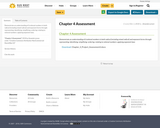
This fun twist on the popular game of Tic-Tac-Toe has students using their calculator skills. The game board could easily be adapted according to skill level and mathematical operation.

This fun twist on the popular game of Tic-Tac-Toe has students using their calculator skills. The game board could easily be adapted according to skill level and mathematical operation.

A collection of coding lessons for all ages. Filter by coding concept, subject, grade or province!

An interactive applet and associated web page that the definition of the center of a regular polygon. The applet presents a regular polygon, where the user can drag any vertex to resize it, and change the number of sides. The center point is shown to always be the point equidistant from every vertex. Applet can be enlarged to full screen size for use with a classroom projector. This resource is a component of the Math Open Reference Interactive Geometry textbook project at http://www.mathopenref.com.

An interactive applet and associated web page that define and illustrate the central angle of a polygon. The applet shows the angle and users can experiment by changing the number of sides and resizing the polygon. The web page has a description and a formula for the central angle given the number of sides. Applet can be enlarged to full screen size for use with a classroom projector. This resource is a component of the Math Open Reference Interactive Geometry textbook project at http://www.mathopenref.com.

An interactive applet and associated web page that demonstrate the central angle of a circle - the angle subtended at the center by two points ion the circle. The applet presents a circle with two points on it that can be dragged. The central angle is shown changing as you drag. Applet can be enlarged to full screen size for use with a classroom projector. This resource is a component of the Math Open Reference Interactive Geometry textbook project at http://www.mathopenref.com.

Demonstrate an understanding of irrational numbers in both radical (including mixed radical) and exponent forms through: representing: identifying: simplifying: ordering: relating to rational numbers: applying exponent laws.

Today we're going to start our two-part unit on data visualization. Up to this point we've discussed raw data - which are just numbers - but usually it's much more useful to represent this information with charts and graphs. There are two types of data we encounter, categorical and quantitative data, and they likewise require different types of visualizations. Today we'll focus on bar charts, pie charts, pictographs, and histograms and show you what they can and cannot tell us about their underlying data as well as some of the ways they can be misused to misinform.

Before completing this assignment, the students must work through their outcome-based work booklets in order to gain some background information on graphs. The booklets include mini assignments from the Math Makes Sense textbook and other digital resources.

An interactive applet and associated web page that demonstrate a chord of a circle. The applet shows a circle and two draggable points on its periphery, with the chord drawn between them. A command button turns on the perpendicular bisector of the chord. As you drag the chord about, you can see that the perpendicular bisector always passes through the center of the circle. Applet can be enlarged to full screen size for use with a classroom projector. This resource is a component of the Math Open Reference Interactive Geometry textbook project at http://www.mathopenref.com.

An interactive applet and associated web page defining a circle. The applet shows a circle where the user can drag the center and a point on the circle. The radius line supports the definition that all points on the circle are a fixed distance from the center. The web page has the definitions of all the circle-related objects, such as diameter, chord etc, with links for each. Applet can be enlarged to full screen size for use with a classroom projector. This resource is a component of the Math Open Reference Interactive Geometry textbook project at http://www.mathopenref.com.

An interactive applet and associated web page that show the properties of a circumcircle of a polygon. The applet shows a regular polygon where the user can drag the vertices to reshape it and alter the number of sides. As the polygon is being varied, the circumcircle is shown, passing through all vertices. The text describes two ways to calculate the radius of the circumcircle, depending on what you are given to start. Applet can be enlarged to full screen size for use with a classroom projector. This resource is a component of the Math Open Reference Interactive Geometry textbook project at http://www.mathopenref.com.

An interactive applet and associated web page that demonstrate the circumference of a circle. The applet shows a circle with a radius line. The radius endpoints are draggable and the circle is resized accordingly. The formula relating radius to circumference is updated continually as you drag. Introduces the idea of Pi. The formula can be hidden for class discussion and estimation. See also the entries for circumference and diameter. See also entries for radius and diameter. Applet can be enlarged to full screen size for use with a classroom projector. This resource is a component of the Math Open Reference Interactive Geometry textbook project at http://www.mathopenref.com.

An interactive applet and associated web page that show the definition and properties of the bounding box of a polygon or set of points. The bounding box is used in other entries to find area using the so-called box method. The grid, coordinates and calculations can be turned on and off for class problem solving. The applet can be printed in the state it appears on the screen to make handouts. The web page has a full definition of a bounding box when the coordinates of the points defining it are known, and has links to other pages relating to coordinate geometry and a worked example. Applet can be enlarged to full screen size for use with a classroom projector. This resource is a component of the Math Open Reference Interactive Geometry textbook project at http://www.mathopenref.com.

Find over 1 million free activities, simulations, exercises, lessons, and games for math & science!
Resources are organized by: Elementary, Middle School, High School & College.

An interactive applet and associated web page that demonstrate the concept of collinear points. Four draggable points are shown. Dragging any one of them will cause the others to move so they are always collinear. A button controls the line that can be drawn through them. Applet can be enlarged to full screen size for use with a classroom projector. This resource is a component of the Math Open Reference Interactive Geometry textbook project at http://www.mathopenref.com.

An interactive applet and associated web page that demonstrate the concept of complementary angles (angles that add to 90 degrees). The applet shows two angles. You can drag the endpoints of each angle and the other angle changes so that they always add to 90 degrees. They are drawn in such a way that it is visually obvious that together they form a right angle, although they are separate on the page. The angle measure readouts can be turned off for class discussions. Applet can be enlarged to full screen size for use with a classroom projector. This resource is a component of the Math Open Reference Interactive Geometry textbook project at http://www.mathopenref.com.

BBC lesson series on Computational Thinking. This series would be a good resource for teachers, and older students. The lesson provide some information, a video clip, and each section in the series has a quiz at the end to check understanding. The start of the topic is broken down into the sections of computational thinking: Decomposition, Pattern Recognition, Abstraction and Algorithms.

An interactive applet and associated web page that demonstrate the concept of a concave polygon - one where at least one interior angle is greater than 180 degrees. The applet shows an irregular polygon initially with one interior angle greater than 180 degrees. The user can drag any vertex and change the number of sides in the range 3..99. When the polygon is concave, the angles that make it so are drawn in red. The goal is to show through experimentation what the concept of concavity really means. Applet can be enlarged to full screen size for use with a classroom projector. This resource is a component of the Math Open Reference Interactive Geometry textbook project at http://www.mathopenref.com.

An interactive applet and associated web page that demonstrate the concept of concentricity. The applet shows two resizeable concentric circles and the common center point. As they are dragged to resize, they remain concentric. Applet can be enlarged to full screen size for use with a classroom projector. This resource is a component of the Math Open Reference Interactive Geometry textbook project at http://www.mathopenref.com.

Today we’re going to talk about confidence intervals. Confidence intervals allow us to quantify our uncertainty, by allowing us to define a range of values for our predictions and assigning a likelihood that something falls within that range. And confidence intervals come up a lot like when you get delivery windows for packages, during elections when pollsters cite margin of errors, and we use them instinctively in everyday decisions. But confidence intervals also demonstrate the tradeoff of accuracy for precision - the greater our confidence, usually the less useful our range.